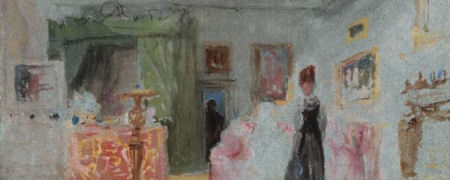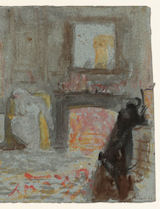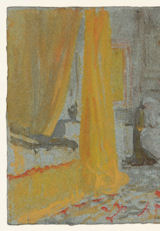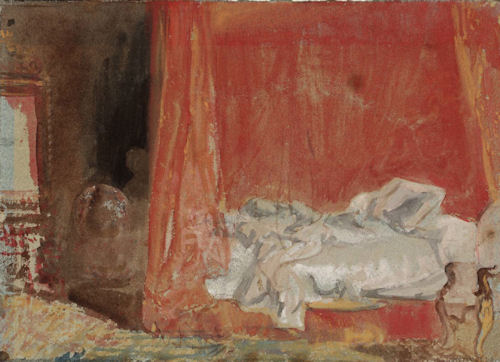




In my earlier discussion of Austen's Novels: The Seven Very Different Novels of Jane Austen, I complain that the themes in Jane Austen's Novels are no less important from first to last. But few can argue that the Novels themselves become infinitely less powerful. I blame the fact that every aspect of every story is filtered through the unique viewpoint of its heroine, beginning with Pride and Prejudice's Elizabeth Bennet, and continuing to the final Novel, never for better, usually for much worse.
But if we were to begin our consideration with Lady Susan, written in Austen's youth although never submitted for publication during her lifetime, continuing with Pride and Prejudice and then on to Sense and Sensibility, and even Northanger Abbey, also unpublished until after her death in 1817, we notice a clear progression through the most powerful, which is to say most interesting of the Seven Deadly Sins:— Lust. Pride. Envy. Avarice, or Greed.
Followed by ...
Yes, Gluttony, Wrath, Sloth, are sinful or, rather, in today's terms, harmful in their effects to oneself and to others. But less powerfully, perhaps, than those earlier subjects?
According to Catholic moral thought, the seven deadly sins are not discrete from other sins, but are instead the origin ("capital" comes from the Latin caput, head) of the others. Vices can be either venial or mortal, depending on the situation, but "are called 'capital' because they engender other sins, other vices".[2]
* * * * *
We have little time today for the concept of any sin, let alone the deadly variety. Pride has evolved into arrogance; Sloth into lack of ambition. Wrath is no worse than being judgmental; Gluttony has become binge eating; Lust is physical attraction when reciprocated, sexual predation if unwelcome. Envy, and Greed (in the sense of Avarice), appear to be the only sins even to have kept their original names and definitions.
Today, study is focussed on the entire fallible human being, as it should be.
A fractured personality whose disparate parts are stitched together with baling wire and alcohol, or gambling, or serial adultery, truly may wish to become more perfect — but not at the expense of shattering the integrated whole which the addiction has seemed to create, at least for a time.
Jane Austen lived from December 16th, 1795 to July 18th, 1817 — 41 years and a few short months — in an England which believed strongly in right and wrong, virtue and sin. Her father was a clergyman, and we have to assume that Austen shared her father's sense of humour as well as his convictions as evidenced by the fact that
... On 1 November 1797 Austen's father sent a letter to London bookseller Thomas Cadell to ask if he had any interest in seeing the manuscript, but the offer was declined by return of post.
Wikipedia Pride and Prejudice, Publication history
We have only to read the dismissive paragraphs contained in the present section's Introduction 3B; Damned with Faint Praise: Pride and Prejudice Yesterday and Today to predict the hostility that would be aroused by any intention on the part of Jane Austen, a young girl in her early twenties, to publish any sort of ruminations on a subject as inflammatory as The Seven Deadly Sins. If one thing can be said with certainty, it's that Austen's decision not to publish Lady Susan during her lifetime was no oversight.
On the other hand, Lady Susan's treatment of inappropriate desire, or Lust, is curiously incomplete, unlike Pride and Prejudice, for example, and Sense and Sensibility, both of which treat the many manifestations of their appropriate Deadly Sin, of Pride, and of Envy, respectively, from varying viewpoints and in meticulously organised detail. I can't help suspecting that Sanditon, her final unfinished Novel, was intended to replace that original juvenile effort.
Like Lady Susan, Sanditon appears to be another amusing study of Lust, but this time with a clever conceit of blaming the works of comtemporary writers, and in particular Clarissa, or The History of a Young Lady, Samuel Richardson's epistolary Novel published 1747/48, with its ruthless but seemingly romantic villain Robert Lovelace, for inflaming a tendency toward inappropriate behaviour on the part of a man as silly and ignorant as he is weak, with the result that
Sir Edward's great object in life was to be seductive ... he regarded it as his duty. — He felt that he was formed to be a dangerous man — quite in the line of the Lovelaces. ... But it was Clara alone on whom he had serious designs; it was Clara whom he meant to seduce.
Sanditon, 1974 The Penguin English Library Edition, Chapter Eight
Who among the most censorious could object? — particularly since the would-be transgressor was this time safely masculine rather than the shockingly predatory and very feminine Lady Susan.
I also wonder if Austen's decision to drop the unfinished Novel The Watsons (with Sanditon contained in the same 1974 Penguin English Library Volume as my copy of Lady Susan, Introduction by Margaret Drabble), was because she found the quite charming characters populating The Watsons to be insufficient fodder for her literary ambitions. That is to say, never in this life could the enchanting Emma Watson be forced into the mould of judgmental righteousness signifying Wrath that so becomes Fanny Price in the succeeding Novel Mansfield Park.
* * * * *
Part 1: Theme, Character, Plot
Part 2: Deadly Sin ... and 'Aura'
Part 3: Film, Fairy Tale, and Happily Ever After
Part 4: Architecture, Absences
What, then, of my original intention to examine each Novel on the basis of Theme, Character, Plot? — Supplemented by a theory of Demotic Possession? Strangely enough, for all its theoretical importance, Sin appears to be merely one additional factor for consideration. The illustrated elements of Pride, on the part of Darcy and Lady Catherine de Bourgh as well as many others including heroine Elizabeth, for example, impart to Pride and Prejudice a certain blithe dismissive tone, or 'aura', if I may be permitted the descriptive term, but I still maintain the extreme vulnerability of the family as the overriding fact of the Novel.
And the same is true, only more so, in Envy's bleak dissonances that fall so disagreeably upon the mind's ear in Sense and Sensibility. And yet that terrible sword of Damocles suspended implacably over the family dining table in Pride and Prejudice, has actually fallen at the opening of Sense and Sensibility, and the female characters are about to be driven from their home. Paradoxically, inexplicably, the actual is less productive of sympathy than apprehension of catastrophe befalling characters we have learned to love.
In my opinion, contemplation through the unkind coloured lenses of Wrath and Envy renders both Mansfield Park and Sense and Sensibility much more enjoyable to an informed reader. On the other hand, once suspicion has been planted that Lady Susan is a study of the Deadly Sin of Lust rather than an amusing and extremely youthful romp through Edwardian bedrooms, the Novel seems much less funny.
The viewer of this webpage is therefore urged to find Lady Susan and read it now, particularly in the above-mentioned Penguin English Library version containing the unfinished Austen Novels The Watsons and Sanditon. Note that a ten-year-old boy's simple reply 'Yes', to an arrogant and patronising remark in The Watsons, is the shortest, funniest, and most devastating bit of repartee in Austen's entire oeuvre.
Details of and links to all Austen-Novel Pictures are found in the Pictures 3B webpage.
As mentioned in my earlier Pictures 3A Did Darcy Lie? webpage, Jane Austen and JMW Turner were born in the same year, Turner on April 23rd and Austen on December 16th. By the time Turner created the above watercolours of Petworth in 1827 Jane Austen had been dead for ten years, but it appears to my inexpert eyes that Austen's Pride and Prejudice and Turner's watercolours share a similar delicacy of expression, economy, or efficiency, or whatever word best describes making a statement using the least possible words or brushstrokes, a certain playfulness, an attention to detail, an enjoyment of people, and as well as a curious modernity despite their dated subject matter.
The Turner bedroom pictures for the present webpage are offered not as illustration of the location where Sin happens — although I may make use of them for such purpose at an appropriate time — but because the safety of our own beds offers what is often the only place to contemplate the complicated universe in which we live.
In fact the choice of JMW Turner's watercolours to illustrate Austen's Novels has given me an invaluable opportunity to deal with the whole subject of Sin and human perfectibility. As nearly as I can ascertain, these Sins were considered bad habits to be avoided or eliminated before they could lead to breaking one or more of the ultimate transgressions enumerated in the Biblical Commandments.
The sin of Greed, for example.
JMW Turner worked on his watercolour interiors during his spare time, but his actual output vastly transcended pretty pictures. His most celebrated painting (Wikipedia entry The Slave Ship, formally Slavers Throwing overboard the Dead and Dying — Typhoon coming on), was first exhibited in 1840 at an anti-slavery conference. Slavery had been abolished in the British Empire in 1833, but Turner hoped that his painting, showing in the foreground floating bodies, still chained hands and feet, might awaken a necessary self-examination in the hearts of those of his viewers benefitting from the slave trade.
Without sin, without the habit of Greed, which can be examined and rectified, there would be no motive for the irreversible breaking of the commandment:
That JMW Turner was a fervent advocate of the abolition of slavery is not surprising. In civil law Latin countries, the journalistic and political élite is always in favour of immediate legislation to counter any problems that arise, rather than examining whether existing laws might be reinforced. No member of the élite actually obeys the laws, of course, but why should anyone? since passage of legislation targeting others is considered to have righted the particular wrong. English or common law élite thought is more inclined to aim at the individual conscience — see the above Wikipedia entry for The Slave Ship, and Mark Twain's description of necessary elapsed time leading to sufficient maturity to accept the moral rightness [my term, not his] of red and yellow skies and floating cast iron chains in Turner's shocking painting.
And whether Mark Twain believed his own words, or was being ironical, is beside the point.
And to believe that Jane Austen in her own modest unassuming fashion, was following this crusading moralistic English tendency in choosing one particular Deadly Sin for each of her Novels, whether acknowledged or not, even to her closest family members, does no injury to her memory. And if she died before completing Sandition, she didn't need her work to be published in order to feel deserved satisfaction.
This Page:—
Jane Austen and the Seven Deadly Sins
 JMW Turner, 1827
JMW Turner, 1827
Title: A Bedroom: A Lady Dressed in Black Standing in a Room with a Green-Curtained
Bed — a Figure in the Doorway, 1827
Medium: Gouache and watercolour on paper
Dimensions: Support 138 x 192 mm
Collection: Tate, Accepted by the nation as part of the Turner Bequest 1856
View by appointment at Tate Britain's Prints
and Drawings Room
Reference: D22745 Turner Bequest CCXLIV 83
[separate detail from right and left sections of watercolour]
 JMW Turner, 1827
JMW Turner, 1827
Title: A Bedroom with a Fire Burning and a Bed with Yellow Curtains
Medium: Gouache and watercolour on paper
Dimensions: Support 142 x 190 mm
Collection: Tate, Accepted by the nation as part of the Turner Bequest 1856
View by appointment at Tate Britain's Prints
and Drawings Room
Reference: D22734 Turner Bequest CCXLIV 76
 JMW Turner, 1827
JMW Turner, 1827
Title: A Bedroom: The Empty Bed
Medium: Gouache and watercolour on paper
Dimensions: Support 138 x 191 mm
Collection: Tate, Accepted by the nation as part of the Turner Bequest 1856
View by appointment at Tate Britain's Prints
and Drawings Room
Reference: D22777
________________________